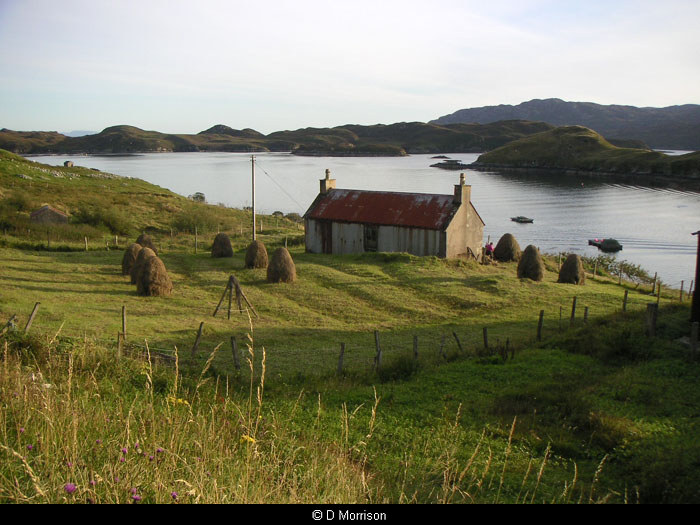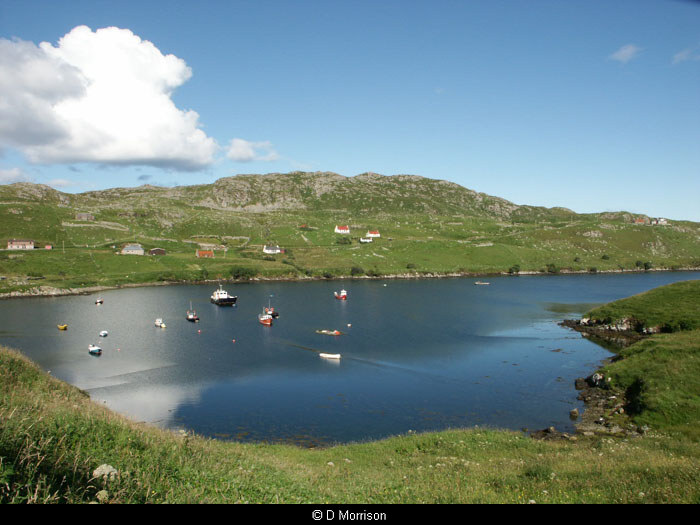43763: Lemreway in 1958
A Geographical Study by Dr J.B.Caird and Members of the Geographical Field Group – 1958
Beth Blowers, Brenda G. Turner and John E. Wearmouth.
Lemreway, the southernmost township of Pairc, comprises of 290 acres arable and outrun divided into thirty-three crofts and 3,025 acres of common pasture. The township is situated on the northern side of Loch Shell round a bay in the shelter of Eilean Iuvard.
The township consists of three distinct areas. A flat, poorly drained area at about 100 feet, part common pasture and part reclaimed as extensions to the crofts, locally known as ‘the Outend’, forms the first sub division. The second area, further west, is of a hummocky nature. To the east, a steep slope rises to an altitude of 400 feet, less than half a mile from the loch shore, forming the third. Two benches are to be seen at about 100 feet on the steeper slope and similar, though wider terraces occur at the same height to the north. It is suggested that the flat area is the bed of moraine-dammed lake, and the hummocky sector is partly morainic and partly ice-eroded rock exposures. A channel eroded through this sector allowed the lake to drain southwards leaving a relatively deeply incised valley through which the present stream flows into the sea.
Of the thirty-three legal crofts In Lemreway, nine comprise of less than five acres, while seventeen are between five and ten acres. Of the remainder, only two exceed fifteen acres and one of those is thirty acres. Six unoccupied crofts are worked by persons other than their tenants, so actually the 290 acres of croft land are shared by twenty-seven holdings. The seventeen-acre ‘outend’ was originally divided between fifteen tenants but confused sub-letting has resulted in four separate holdings directly occupying nine acres, and working another four acres. Thus, the outend today must be regarded as the monopoly of four ‘unofficial’ holders.
Little more than a quarter of the croft land is cultivable and even less is actually cultivated today. The broken terrain and the stony nature of the soil has permitted the cultivation of the tiny ‘lazybeds’ and the total cultivation area is now about 48 acres. Only the strips of land on the gentler slopes, where the soils are deeper, are now cultivated, but every croft shows signs of former more extensive lazybed cultivation, often covering at least two acres. For example, on the east side, natural hay is cut on the well-marked lazybeds at about 225 feet.
Oats and potatoes, 29.5 and 16 acres respectively, occupy almost all of the cultivated ground. Most crofts grow about half an acre of potatoes and one acre of oats; both acreages have declined, the former with a declining population and the latter with a reduction in the numbers of cattle; hay has increased importance. No bere is now grown, though before 1900 it was preferred to oats. Ruins of the bere mill, which ceased to function at the beginning of the century, can still be seen. Fifty-nine acres of natural grass are cut for hay but only four crofters had sown grass for hay in 1958, about three acres in all. Few vegetables other than potatoes are grown though carrots are said to grow well, and formerly turnips and cabbages were grown. The soil needs careful preparation to be productive and almost every crofter used some seaweed and at least twenty drew subsidies for lime and artificial fertilisers in 1958.
Stock totals have declined recently but the township has 36 cows and 22 calves. Only one croft is without cattle and 22 of the 33 working units have a cow and a calf. The township has an Ayrshire bull on loan from the Department of Agriculture; one of the few remaining elements of the co-operative township system is that this animal is fed by the crofters, in rotation, during the winter.
All but two of the crofters keep sheep; stocks vary between ten and 120 per holding but the majority have about 23 ewes with 10 lambs. Although numbers have declined recently, the 3,025 acres of very moderate common pasture support a flock of about 1,150 sheep, including about 650 breeding ewes and about 300 lambs.
The souming is not enforced in Lemreway and it is remarkable that the stock tallies almost exactly to the souming. An examination of the sheep soum reveals that the stock of 917 (excluding lambs) considerably exceeds the sheep soum of 626. It is interesting that it is always the working units of over 10 acres that are overstocked; of twelve such units, eight keep more sheep than they are entitled to. Most of these crofts are grouped on the eastern side of the township where the crofts have a larger outrun.
Thus, while overgrazing is not so severe as in many townships, it represents a potential threat, particularly if the common pasture is not improved. However, in 1958 ten acres of the common pasture have been enclosed and re-seeded. Six acres were sown with ordinary mixed grass seed, two acres with pelleted seed and two acres with pelleted and inoculated seed. The eleven crofters taking part in the scheme put on 100 tons of sand to help drain and aerate the peaty soil, 2.5 tons of ground mineral phosphate and two tons of concentrated compound fertiliser, grades 1 and 2 – all of it by hand. The area was sown in May 1958: By the following August there was a striking difference between it and the untreated pasture. Next spring, eleven cows will be grazed on this area. With the success of this scheme, it is hoped that more of the crofters will co-operate in re-seeding further areas.
The West Highland Survey Township Card describes Lemreway as "predominantly a fishing township". The remains of an old curing station are visible today and until 1947 there were twelve boats operating from Lemreway. A declining market, increasing cost of gear for obsolescent boats and the lack of a landing stage led to the decline of the industry in this township. Today there is one fishing boat which lands it’s catch at Stornoway: working with modern equipment, drift and ring nets, it provides a regular income for a crew of six.
An examination of the population statistics proves interesting, especially when compared with those for Orinsay. Lemreway’s resident population of just over 70 males and 70 females is large considering that there are six unoccupied crofts. Eleven of the crofts have more than one house and the cottar population forms over a third of the total residents. More than two thirds of this resident population is in the two important age groups- between 15 and 64. With over forty resident males in the working age group, Lemreway provides a striking contrast to the other crofting townships in Park.
Fourteen men are full-time croft workers, while nine others find work in ancillary occupations such as weaving and fishing. A further eight supplement their croft work with regular employment – a postmaster and a postman, a bus driver, a lorry driver and several weavers. Just over thirty people work away from the township permanently, fourteen in the Merchant Navy and nine girls in domestic service, while a further nine engage in seasonal work.
Emigration from the township has continued steadily with forty people leaving since 1939. Nevertheless, Lemreway has a larger proportionate resident population than most townships.
Only four thatched houses are occupied and housing conditions are generally good. Every house has electricity but, with four exceptions, water has to be carried from springs and wells. Most of the present houses were constructed in the 1930’s and they are usually near to the road. Ruins of the old houses remain, some being used as byres, and these were built either along the shore or up the slope in the shelter of the hills, where the house was near the sheep, the peat and the springs. Today’s supplies of food, peat and even seaweed are brought by road.
Mention must be made of the possibilities of the tourist trade in Lemreway with its most attractive situation and reasonable road connections. An approach has been made to the Scottish Youth Hostels Association and while hostellers could not greatly increase the income of the residents, they would stimulate interest in the area. Accommodation for summer visitors, other than relatives of the crofters, is difficult to find but it seems that at least three houses could be used.
It is possible to be optimistic about the future of Lemreway, as at the moment considerable enterprise is being shown. A Ferguson tractor, bought this year by a man returning from whaling, is an example. It is to be hired out and could be put to good use in some parts, especially on the Outend. The attempt to improve the common pasture and the new extensions to the neatly painted houses all reflect a combined effort to improve conditions. The old economy of crofter-fisherman is adapted to modern times and crofter-weaver, crofter-postman and crofter-bus driver are the contemporary employment combinations.
The pessimism and apathy noticed in many crofters is to be found in Lemreway but above this is the impression of enterprise. If Lemreway can continue to adapt itself to changing conditions, it may be able to combat the ‘drift to Glasgow’ and continue as a successful community.
Details
- Record Type:
- Story, Report or Tradition
- Date:
- 1958
- Type Of Story Report Tradition:
- Report
- Record Maintained by:
- CEP

